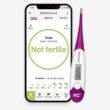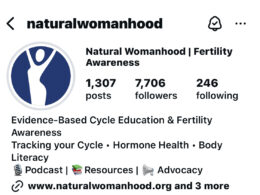How much did you learn about your body as a teen? Did you feel confident with all the changes of puberty and knowing what was happening when you got a period? If you’re like most of us, the answer is probably… “Not much,” and “No, not at all.” Maybe your parents sat down and gave you “the talk,” which probably amounted to some form of “Just don’t don’t do it,” and may or may not have involved any basics of biology. Or, maybe everything you learned about sex and reproduction came from the giggled whispers of friends, or from a sex-ed class with a decidedly “Since you’re going to do this anyway, here’s how to do it safely” -bent.
My experience of learning about my body in high school health class consisted of some basic male and female anatomy, and a list of birth control options. The whole situation was awkward and embarrassing since I was in a room full of snickering boys, and menstrual cycles and fertility were never discussed…. At all…. making those subjects feel taboo and somehow dirty.
Correcting the fallout from generations of “passing the buck” on authentic sex ed
The unsurprising result of all this, is that many of us reach adulthood with little real knowledge about our fertility. What’s more, we grow up seeing sex glamorized by magazines and movies, yet witnessing the very real fallout from this casual approach to sex in the lives of our friends, our parents, and maybe even our own.
It’s therefore understandable that you may be wary of teaching your children about the workings of their reproductive system. The thought of teaching your teen daughter all the details of how her menstrual cycle works, and how to chart her cycle so she knows when she’s ovulating, likely brings up concerns. It may also be incredibly daunting, if you’ve never had an understanding of these things yourself.
On the surface, cycle charting could seem age inappropriate for young girls, and so even the daughters of women who chart their cycles may be unaware of how to teach their daughters how to do it for themselves. But allow me to address a few common misconceptions about teaching our daughters fertility awareness, and show you what really happens when we give our daughters the gift of understanding their bodies.
Myth #1: Teens can’t learn to chart because their cycles are irregular
It’s true that when girls first begin menstruating, their cycles are often irregular and their periods very unpredictable. In fact, this is completely normal! This is also exactly what makes cycle charting so useful for teens. When a girl learns to observe her cervical mucus, she’ll know when she’s ovulating, and that she can confidently expect her period to arrive approximately two weeks later. And the longer she charts, the more confident and self-aware a teen will become of the patterns she sees in her cycles, and in her hormone, mood, and energy shifts.
It’s also incredibly useful to be able to determine whether cycle irregularity is normal in a teen girl, versus a signal that a more serious underlying issue is at play. Cassondra Moriarty states in the Natural Womanhood article “The Links between Irregular Cycles, Birth Control, and Early Death:”
“While irregular periods can be normal in the beginning years of puberty, there should be a progression over time to more regularity. In the case that a young girl experiences irregular periods that don’t progress toward maturation, this is often a sign of some type of hormonal imbalance.”
Sometimes, when a young girl has irregular cycles, it’s because she has an underlying pathology (like polycystic ovary syndrome or endometriosis) leading to unbalanced hormones, or detrimental lifestyle factors like poor sleep or diet, or too much stress. No matter the cause of cycle irregularity, charting her menstrual cycle can alert your daughter (and, importantly, you!) to when there’s a problem with her cycle.
Through charting, your daughter can learn to look for signs of ovulation, and compare her cycle length, luteal phase length, and the length and heaviness of her period to what’s considered normal. When her cycle is off, you can both use her charts to get medical help from a doctor who specializes in using charting to heal and restore her normal cycle without resorting to hormonal birth control (otherwise known as restorative reproductive medicine). Imagine the confidence your daughter would feel in taking this information to such a doctor!
Myth #2: Fertility cycle charting is too complicated and overwhelming for teen girls
Yes, there is much to learn about how our bodies work. Whether we are an adult or a teen when learning this important information, it takes time to feel comfortable with observing our bodies and recording what we see each day. But can it really be argued that learning about how her body works is asking too much of a teen girl? She’s expected to learn chemistry, algebra, and all the other intricacies of human biology in school! Therefore, it’s my belief that teen girls are more than capable of learning about the biology of their own bodies.
Yes, the whole idea of learning to observe her body and chart her cycle may feel overwhelming at first to many girls (and to many of us adults for that matter), which begs the question: Do girls even want to learn about their fertility? Ignorance is bliss, right? I’ll admit, there are parts of cycle charting that get tiring and frustrating, like remembering to record what you saw each night before bed, or when you can’t figure out your cycle pattern because it doesn’t look like what you learned it should look like.
Well, ignorance may be bliss for some, but knowledge is always power. When girls have learned about their amazing bodies and charted several cycles, most find it incredibly empowering. In fact, in her work with teens, Cassondra Moriarty has found that “teens are eager to learn more about ovulation, hormonal health, and menstrual cycles—yes, even about cervical fluid! They are willing and able to chart.”
Likewise, Leslie Botha has found in her work with at-risk teen girls that “teens who are taught fertility awareness and how to chart their cycles can regain control of their life.” The truth is, when teenage girls are given the opportunity to understand their changing bodies and emotions better, when they can predict their periods and feel confident in having a bit of control over their bodies, it gives them much-needed confidence in a time when so much of their life can feel out of control.
Myth #3: Teaching your daughter about her fertility will rob her of her innocence
This is a common concern for many parents: If we teach our young ones all the details of fertility, it can feel scandalous. But what’s so scandalous about how our bodies were created? Of course, each parent must decide when their child is ready to learn all the details of where babies come from, but look around at our culture. Unless you live in a void, the internet, movies, and media are all working to strip our kids of their innocence. Even when we try our best to shelter our kids, they see and hear adult things all around them on billboards, in “kid” movies, in advertising and the like. This is why we must be proactive in teaching our children the dignity and beauty of our bodies, so they are empowered to take care of their own bodies—and respect one another’s.
All of this can begin with simple conversations when your children are young, and progress to teaching your daughter all the details of fertility awareness and cycle charting when you deem she’s old enough. Teaching our children about the intricacies of their bodies and fertility is one of the best ways to give them respect and appreciation for their bodies—and the bodies of others.
This leads me to the next misconception—and the one that probably gives many parents the most pause when it comes to teaching their children about their fertility…
Myth #4: Understanding when she’s fertile and infertile will make your teen more likely to engage in sexual activity
Sure, it’s possible that a girl who knows when she’s ovulating will feel more comfortable engaging in sexual activity when she knows she’s not fertile. But does the data actually bear this out as being the most likely result of teaching girls how to chart their cycles?
In a word: No.
To address this concern, let’s look at an actual study done on this very topic.
Teen STAR is a teen cycle charting curriculum that has been used worldwide with very encouraging results. Their teaching philosophy is guided by the belief “that by disclosing the full range of what it means to be human, we help provide adolescents and young adults with the knowledge needed to make mature, responsible decisions.”
The Teen STAR program has been evaluated by the nonprofit research organization Child Trends, which found “that this program is effective in reducing the rate of pregnancy, delaying the onset of sexual activity, decreasing sexual activity in sexually-active youth, and improving attitudes towards abstinence, compared with students in the no-treatment groups.” Child Trends Magazine also ranked Teen STAR as “One of the top sexuality education programs in the world,” in 2014.
An analysis of the exit questionnaires from teens completing the Teen STAR program “concluded that teaching adolescent girls how to track their fertility patterns had a positive correlation not only with maintaining virginity, but also with discontinuing sexual activity.” Furthermore, according to data collected in 2014, “40-50% of previously sexually active males discontinued sexual activity” after participating in the program.
As it turns out, meaningful sexual education that urges teens towards respect and responsibility for their fertility actually has some pretty amazing results.
Consider these myths busted.
To sum, the benefits of fertility awareness and cycle charting for teens goes far beyond the physical. Girls come to terms with their changing bodies, develop a healthy respect for their fertility and sexuality, and see the beauty of how their bodies were designed to work. This new confidence makes it easier to choose the good for themselves (and for others) even amidst peer pressure. Now, who doesn’t want that for their daughter?
Additional Reading:
Cycle mindfulness: What happens when you teach fertility awareness to teen girls
Why I’m teaching my daughters how to chart their menstrual cycles
Signs that your daughter will be getting her first period soon—and how to prepare her for it
The Links between Irregular Cycles, Birth Control, and Early Death
Study Shows Link Between Teen Birth Control Use and Adult Depression
Empowering Teenage Girls to Know Their Bodies: A conversation with Emily Sederstrand











